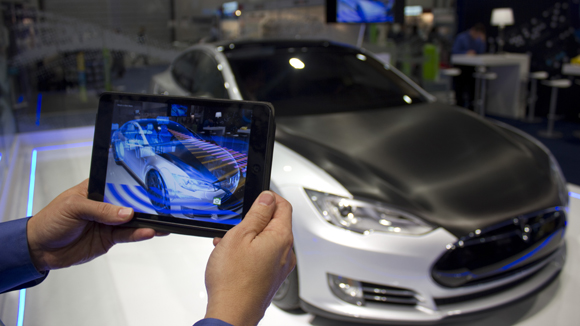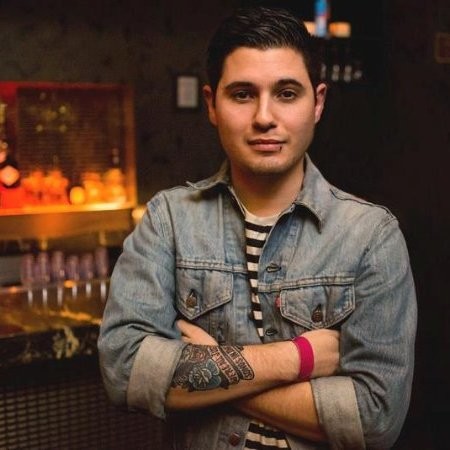Delphi's 5-sensor system wants to take total control of your car
Too bad it can't detect dogs (yet)

Delphi, like many other car and technology companies, envisions a future in which cars drive themselves. At CES 2014, the auto tech firm contested that it's got the gear to make that vision a reality.
During the expo, it showed off a Tesla S equipped with five sensors, including four radars and one radar-camera combo unit Delphi calls "RACam."
RACam - "the world's first integrated radar and camera in a single module" - was mounted on the car's front, with four additional radars situated on each of the vehicle's four corners.
Delphi contends that by using these five sensors, cars will eventually be able to detect and avoid oncoming collisions using more than just brakes.
Raining cats and dogs
"The number [of accidents] that you can reduce with just longitudinal control - with just speed control - is limited, because there are some you just can't avoid using braking alone," Delphi Global Product Manager of Safety Electronics Scott Pagington told TechRadar in the Las Vegas.
But with the five sensor-system's 360 degrees of readings, a car can safely swerve out of the way of obstacles in front of it because the side radars let it check the lanes around it for obstacles as well.
"If you're going to avoid a collision, you can't create another collision," Pagington said. A car equipped with Delphi's system will check the lanes to its right and left, and if there are no cars coming up on one side, it can simply switch lanes to avoid pedestrians, stalled cars and other obstacles.
Get daily insight, inspiration and deals in your inbox
Sign up for breaking news, reviews, opinion, top tech deals, and more.

He said the sensors, which Delphi is developing in collaboration with Volvo and Mobileye, can detect pedestrians as well as creatures like moose and deer - but not something as small as a dog or cat.
"Right now we don't have the capability to detect dogs. Those are too small," he said, though he added, "We will eventually."
The radar and camera complement one other nicely, Pagington explained. For example, the radar is better at measuring distance and speed, while the camera is better at identifying specific objects. The radar, unsurprisingly, also does a better job of seeing through weather.
"When you combine those two technologies you get a system that has very few weaknesses," he contended.
'Democratization of safety'
Pagington said Delphi wants to start putting this technology in cars that anyone can afford, not just the Tesla S.
"All this technology is getting down to the point where the price points are really being pushed down," he said. "And the really great part about that now is as we see these greater volumes, we're able to reduce the price points. Well, then we can put it on more vehicles."
He continued, "We call it kind of the democratization of safety. Safety should not be something that's reserved for those who can afford a luxury vehicle. It should be something that's available to everybody. So we're trying to make sure that that happens."
But don't expect your Honda Civic to start driving you around by the end of the year.
"We think it's going to be slow, particularly that last little bit," Pagington said. "There are lots of these steps we're going to be able to implement, but the last three feet, if you will, to get to a car that completely is self-driving and takes care of itself - we think that's out there quite a ways still."
He cited regulation issues, as well as technological barriers. We suggested that for self-driving cars, 99% accident-free simply isn't good enough, and Pagington agreed. Plus consumers themselves may rebel against completely automated cars, he suggested.
Despite buzz in recent years generated by the likes of Google, "automated driving has really been around for a really long time," Pagington said.
"Automatic transmissions is an automated driving technology. Anti-lock brakes, cruise control, things like that. So automated driving is not something new. It's just that it's becoming more and more visible to the end consumer, and it's evolving."
Michael Rougeau is a former freelance news writer for TechRadar. Studying at Goldsmiths, University of London, and Northeastern University, Michael has bylines at Kotaku, 1UP, G4, Complex Magazine, Digital Trends, GamesRadar, GameSpot, IFC, Animal New York, @Gamer, Inside the Magic, Comic Book Resources, Zap2It, TabTimes, GameZone, Cheat Code Central, Gameshark, Gameranx, The Industry, Debonair Mag, Kombo, and others.
Micheal also spent time as the Games Editor for Playboy.com, and was the managing editor at GameSpot before becoming an Animal Care Manager for Wags and Walks.
